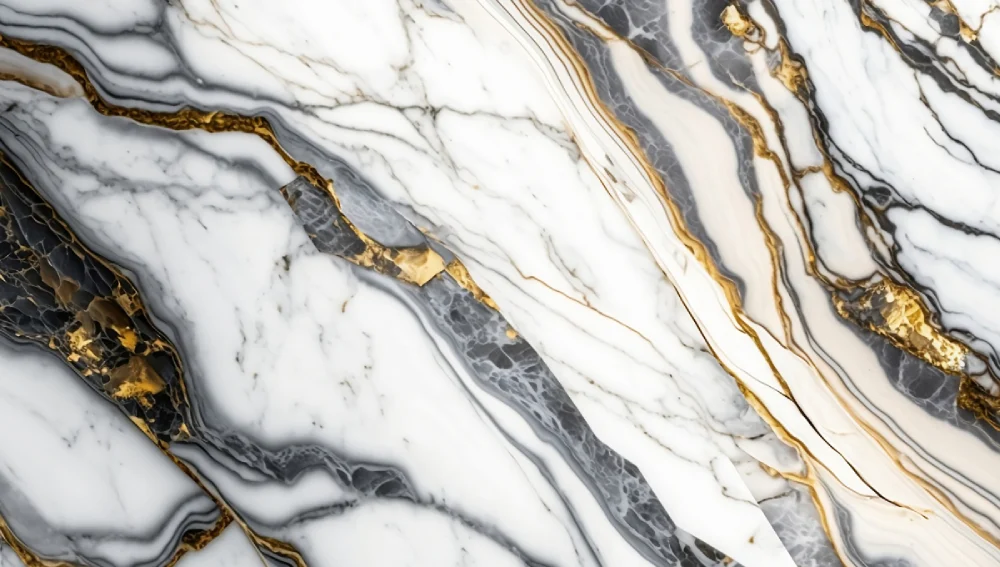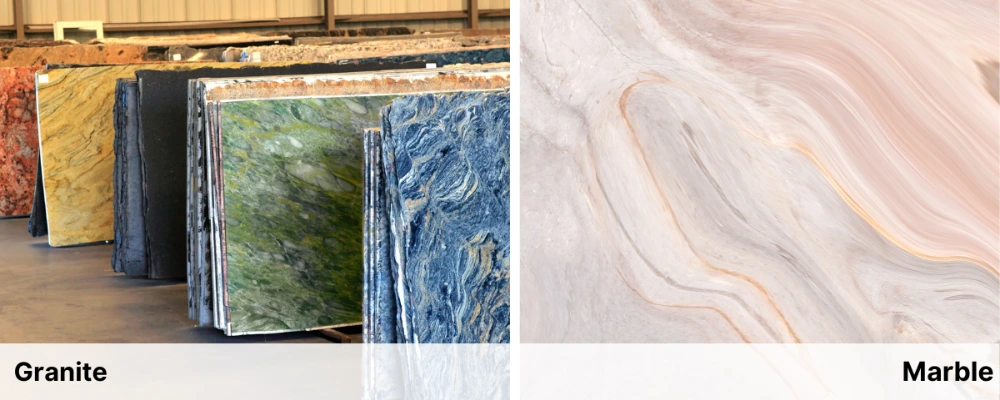There are numerous materials available in the market today that allow versatile finishing options in the construction industry. Two of the most commonly used materials are marble and granite Both of these options have the power to uplift the look of homes and are durable. But which one to choose? Don’t look any further; this blog helps you understand the differences between marbles and granite, so that you can make an informed decisions.
Granite

Granite is an igneous rock that mainly contains quartz, mica, and feldspar. Granite is formed because of the magma produced due to slow crystallisation of the earth’s surface, giving it a unique sparkle with a different range of colours.
Composition of Granite
- Granite is made of different materials, mainly quartz, that gives its glossy look and contributes to twenty to sixty percent of the rock.
- Feldspar, specifically made of plagioclase, contributes around thirty-five to forty-five percent of the granite. The feldspar can be grey, white, or pink.
- Mica contributes to only five to ten percent of the total rock and gives the granite it’s dark specks.
- However, other minerals, namely amphibole and hornblende, can also be present in the granite.
Applications of Granite in Construction
Granite has a wide range of applications, and some of them are listed below:
- Interiors: Granite is commonly used for flooring, creating countertops, cladding, dadoing, fireplace mantels and kitchen backsplashes.
- Exteriors: Granite can be used in landscaping for flooring, creating cornices, parapets, coping and sculptural elements. It is used for cladding on built facades and can also be used as a building block for construction.The remaining granite from construction, when crushed, can be used in the construction of roads and for ballast in railways.
Marble

Marble is a metamorphic rock that is primarily composed of calcite, a crystalline form of calcium carbonate. It is formed when limestone is subjected to heat and pressure over millions of years.
Marble is extremely famous for its wide range of colours, distinctive patterns, and beauty.
Composition of Marble
- The main composition of marble is calcite, which is a predominant mineral that is white in colour and has crystalline structure. Calcite contributes to around ninety to ninety-eight percent of marble.
- The next mineral is dolomite, which can reduce calcite content or cause a disturbance in its colour, giving it a light grey or pinkish hue.
- Quartz is the least material that contributes to only five percent of the marble. It is primarily found in impure marbles.
Applications of Marble in Construction
Marble does have a variety of applications, and a few are highlighted below:
Architecture: Marble has been widely used in architecture for centuries. It is used in staircases, columns, and in flooring to give a luxurious look to the building. It is also used to create countertops, sculptural elements, elevational cladding and as a building block.
Famous Structures Made With Marble
Greece, The Parthenon, is made utilising Pentelic marble, and it exhibits everdying beauty in marble architecture.
India, Taj Mahal—it is an UNESCO-recognised World Heritage Site that is an example of marble elegance.
Differences Between Granite and Marble
Both granite and marble have their own distinct qualities, which are listed below:
| Characteristics | Granite | Marble |
| Type | Igneous rock | Metamorphic rock |
| Composition | The primary contributor is quartz around twenty to sixty percent, feldspar around thirty-five to forty five percent, and other minerals. | Calcite contributes around ninety to ninety eight percent with mica, quartz, dolomite, and other impurities. |
| Differences in Colour | Granite is available in different colours starting from pink, black, grey, red, blue, and green. | Marble is most commonly found in white colour, but also available in cream, green, red, blue and, pink colours. |
| Process of Formation | Granites are formed as a result of magma cooling beneath the surface of earth. | Under heat, limestone is formed by metamorphism of rocks which results in the formation of marble. |
| Texture | It is generally coarse with visible crystals. | Marble is finely grained with smooth structure. |
| Hardness | It is harder and scratch resistant with 6-7 on Mohs scale. | It is softer and prone to scratches that lie 3-4 on Mohs scale. |
| Maintenance | They require low maintenance and need sealing or polishing only once in a year. | They need to be taken care of regularly and require high maintenance. |
| Heat Resistance | They are extremely resistant to heat and can withstand pans and hot pots. | They have poor resistance to heat. |
| Cost | They are commonly affordable; however, the cost varies depending on the colour and texture. | They are typically costly, specifically for rare types of marbles like Calacatta. |
| Famous structures | Mount Rushmore USA, Granite Belt Australia. | Taj Mahal, India, The Parthenon, Greece. |
| Geological Significance | They are linked with mountain buildings and tectonic plates. | They can give insights into the geological history of the place as they are the result of carbonate rocks. |
Conclusion
In summary, granite and marble are wonders that elevate the aesthetics in your building instantly. However, they have distinct differences between each other. Both granite and marble are available in a wide range of flooring, colors, and finishes. Granite requires low maintenance, but marble needs to be checked frequently. Hence, it is important to understand the differences and opt for the option that best suits your needs and budget.
FAQs
Granite is better at withstanding heat, scratches, and chips compared to marble. However, you can juggle depending on the area of utility and requirements.
Yes, marble is quite expensive compared to granite and requires high maintenance.
Black-coloured granite is costlier and is in high demand due to its rarity and distinguished appearance.

